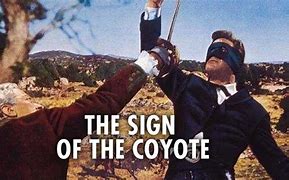PHENOMENALITY: *uncanny*
MYTHICITY: *fair*
FRYEAN MYTHOS: *adventure*
CAMPBELLIAN FUNCTION: *sociological*
Even without knowing much about the history of California's annexation by the United States, I knew that such a transition of power was not going to be as hunky-dory as depicted in 2005's LEGEND OF ZORRO. For that reason, I immediately liked that SIGN was set in 1847 and that it showed that there was quite a bit of conflict between the new regime of the Americans, dominantly of English extraction, and of the native Californians, dominantly of Spanish descent.
SIGN, a Spanish-Italian co-production, is also interesting in providing info on how Europeans related to the public domain character of Zorro. Jose Mallorqui, a Spanish writer, invented "El Coyote," a patent Zorro imitation, in 1943, and produced almost 200 works in this series. Two Mexican-Spanish movies adapted the character in 1954, three years before Walt Disney initiated its ZORRO series, and SIGN was one of two sixties films adapting the Mallorqui character again, albeit with totally different casts and directors.
For the first thirty minutes, director/co-writer Mario (EYE IN THE LABYRINTH) Caiano creates considerable empathy for the fate of the Californians under the rule of Governor Parker, who's just the norteamericano version of every Spanish tyrant Zorro ever faced. A particular standout is a courtroom scene, in which an American gunfighter is let off the hook for killing an innocent woman while trying to shoot a Californian.
On the minus side, the hero is introduced with very little fanfare, as if he's already been around for a while. He's Cesar (Fernando Casanova), whose name just happens to be that of Zorro's offspring in the movie DON Q, SON OF ZORRO, and his elderly father's name, at least in the translated version I watched, is Diego. However, the father of this Cesar has never been a masked vigilante and plays little part in the narrative. Cesar doesn't exactly duplicate the fey qualities of the original Diego, but he refuses to take direct action in the face of tyranny, which is enough to arouse the contempt of his leading lady Leonora. Naturally, he uses the alter ego of El Coyote-- essentially a charro outfit with a domino mask-- to battle the evil Americans. Usually El Coyote works alone, but he's able to call upon a small collection of Californians who don masks to help him. There's one odd moment when the hero is aided by one of his family's female servants in a version of his masked attire, but her masquerade is not explained.
So in the end SIGN soon settles into just another Zorro-type flick, with the usual swordfights and romantic interludes between the cute noblewoman and the masked swashbuckler. Most disappointingly, the menace of the crude Americans is largely brushed off once Parker is killed. Aside from Caiano, the only other Italian name I spotted in the credits was that of Piero Lulli, a veteran of several peplum adventures.

No comments:
Post a Comment